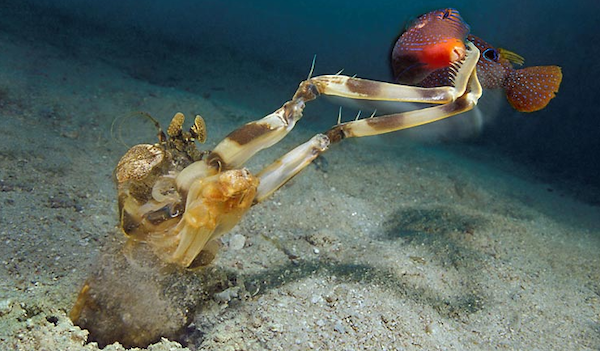Facts about the Stomatopoda
Briefing
Stomatopoda, as known as "Mantis Shrimp" or "stomatopod", has a great if not the greater vision among animals. They are monogamous, can learn and remember individuals with which they interact and many are capable to develop complex social behaviours. In captivity they can be very dangerous to the others neighbours.
In the follow sections of this page, we will describe each one of the traits that we mentioned above and will discuss more traits about this amazing animal.
Formal Introduction

The binomial name (scientific name) of Mantis Shrimp is Odontodactylus scyllarus. They typically grow to around 10 cm in length, while a few can reach up to 38 cm. A mantis shrimp's carapace (the hard, thick shell that covers crustaceans and some other species) covers only the rear part of the head and the first four segments of the thorax.
Varieties range in colour from shades of brown to vivid colours, with more than 450 species of mantis shrimp being known. They are among the most important predators in many shallow, tropical and subtropical marine habitats. However, despite being common, they are poorly understood, as many species spend most of their lives tucked away in burrows and holes.
Social Behaviour

They can learn and remember well, and are able to recognise individual neighbours with which they frequently interact. They can recognise them by visual signs and even by individual smell. Many have developed complex social behaviours to defend their space from rivals.
In a lifetime, they can have as many as 20 or 30 breeding episodes. Depending on the species, the eggs can be laid and kept in a burrow, or they can be carried around under the female's tail until they hatch. Also depending on the species, males and females may come together only to mate, or they may bond in monogamous, long-term relationships.
In the monogamous species, the mantis shrimps remain with the same partner up to 20 years. They share the same burrow and may be able to coordinate their activities. Both sexes often take care of the eggs (bi-parental care).
Aquarium King

While some aquarists value mantis shrimps and keep them in captivity, others consider them harmful pests, because they are voracious predators, eating other desirable inhabitants of the tank. The live rock with mantis shrimp burrows is considered useful by some in the marine aquarium trade and is often collected.
A piece of live rock not uncommonly conveys a live mantis shrimp into an aquarium. Once inside the tank, it may feed on fish and other inhabitants, and is notoriously difficult to catch when established in a well-stocked tank.
Super Powers
When we want to refer to a great atribute or a remarkable trait is common to make a relation with an animal which is a symbol of that feature, like: they are proud as a Lion, or he is strong as a Bull or she have eyes of an Eagle. Well, after know Mantis Shrimp, maybe we should reconsider our reference of strenght and good eyes.
Eagle's Eyes?

The eyes of the mantis shrimp are mounted on mobile stalks and can move independently of each other. They are thought to have the most complex eyes in the animal kingdom and have the most complex visual system ever discovered and only this trait have material for an entire study, as we can see here and here. Compared with the three types of photoreceptor cells that humans possess in their eyes, the eyes of a mantis shrimp have between 12 and 16 types of photoreceptor cells.
Despite the impressive range of wavelengths that mantis shrimp have the ability to see, they do not have the ability to discriminate wavelengths less than 25 nm apart. It is suggested that not discriminating between closely positioned wavelengths allows these organisms to make determinations of its surroundings with little processing delay. Having little delay in evaluating surroundings is important for mantis shrimp, since they are territorial and frequently in combat.
Bull's Strenght?

A mantis shrimp contracts its muscles by pulling its arms far back. At the maximum flexion of its muscles, a latch mechanism locks the contracted arm off. When the latch is released, all of the muscle force is released at once.
When they strike, the mantis move their arms at speeds of up to 45 miles per hour (20 meters per second). Delivering a strike as powerful as a 22-caliber bullet takes more than strength, though. Researchers on mantis shrimp anatomy discovered a section on the arm shaped like a saddle.
The mantis shrimp punches with 200 pounds (91 kilograms) of force. Its arms move so fast that they practically tear the water apart. Like their visual system, there are studies about their strikes and predator behaviour.